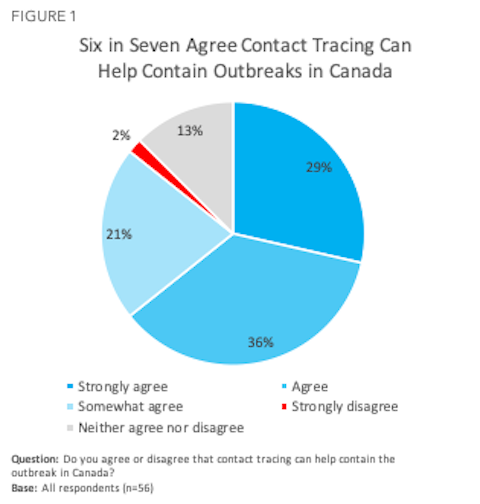What do the COVID-19 responses of South Korea, Japan, Vietnam, and Taiwan have in common? Active contact tracing. These economies embraced various forms of contact tracing as a means to contain the spread of COVID-19 and were all particularly successful. The Asia Pacific Foundation of Canada is analyzing measures adopted in various Asia Pacific countries to prevent the spread of the disease. We looked into how these countries utilized contact tracing as part of their containment strategies and polled Canadians to get their perceptions on implementing similar contact tracing measures in Canada. At this crucial time in the fight against COVID-19, where Canadian provinces are starting to integrate contact tracing initiatives into their infection control methods, experiences in Asia can be particularly informative.
The extraordinary success of contact tracing in Asia
Contact tracing is the monitoring process of people at risk of having been infected by a virus because of their proximity to an infected person. Despite adopting radically different contact tracing strategies, from the traditional labour-intensive method to an array of technology-based measures, countries that embraced contact tracing have been particularly successful at containing the COVID-19 virus. Many Asian countries developed contact tracing capacity in the aftermath of other deadly epidemics such as SARS and MERS. Here is how Japan, South Korea, Taiwan, and Vietnam implemented their contact tracing strategies.
Japan
Japan relied heavily on contact tracing in its early efforts to curb the spread of COVID-19. Although Japan will soon be launching an app to facilitate contact tracing, its experience illustrates the efficiency of traditional contact tracing. The low-tech contact tracing process initially used in Japan mainly consisted of phone calls, emails, and visits to patients. While other countries focused on “prospective” investigations aimed at tracking individuals who were potentially infected, Japan relied on a “retrospective” approach, which aims to trace back the chain of transmission to find the source of the infection. Health capacity and preparedness enabled Japan to adopt such an approach at the onset of the COVID-19 outbreak. The country had invested massively in recent years to set up hundreds of public health centres and trained thousands of contact tracers in response to previous outbreaks of infectious diseases.
South Korea
Contact tracing is at the core of the ‘Trace, Test, and Treat’ approach in South Korea, which earned it international praise. Following struggles with SARS and MERS, the country developed the capacity to conduct broad traditional contact tracing. While the method is still common practice, the availability of mass information about the movement of people allowed the South Korean government to roll-out automated contact tracing. Rapidly, data from credit and debit cards, phone location logs, and an extensive network of surveillance cameras were mobilized and used to trace the movements of people in the days leading to a positive test. This somewhat invasive method, usually used to track criminals, allowed authorities to alert people at risk of having contracted the virus. The government also launched the Self-isolation Safety Application app to monitor quarantined patients’ health and encourage them to stay home to complement the contact tracing system already in place. The digital infrastructure and the established rules around the use of technology and privacy during a crisis were critical to the implementation of contact tracing in South Korea.
Taiwan
Taiwan made use of its technology, big data, and innovation to develop a successful contact tracing approach. In January, after 3,000 potentially-sick people disembarked from the Diamond Princess Cruise Ship for a day at Keelung Harbour in Taiwan, authorities have been using cellphone geolocation data – as well as security-camera footage and credit card location data – to track people at risk and to trace their contacts. For infected patients, travel data from the past 14-days – the incubation period of the virus – was retrieved to help identify people at risk. Leveraging the same data, Taiwan was also one of the first to launch a mobile phone tracking app, used to enforce quarantines. The ready technological infrastructure and institutional landscape that enabled big data tracing in Taiwan are the results of a disaster-management centre (NHCC) established after the painful experience with SARS.
Vietnam
The success of Vietnam’s response to COVID-19 is attributable primarily to the states’ proactive and timely interventions. Aggressive contact tracing is one such intervention. It was made possible by the rapid mobilization of health professionals, public security personnel, military, and civil servants. Their relentless manual contact tracing efforts sometimes involved hundreds of people to trace contacts for a single patient. Surveillance camera footage and mobile applications also supported traditional contact tracing efforts. Additionally, Vietnam’s Ministry of Information and Communications developed the NCOVI application in early March to raise awareness about the virus and monitor citizens’ health voluntarily to guide contact tracing. Improvements in the Vietnamese health system in response to other infectious diseases such as SARS, MERS, measles, and dengue provided the state with the capacity to take such an aggressive contact tracing approach.
Canadian perceptions of contact tracing
As the Canadian economy reopens, Canadian leaders see contact tracing as an integral part of the COVID-19 response, and so do Canadians. Between April 29 to May 21, APF Canada conducted a small poll titled Canadian Views on Contact Tracing in the Asia Pacific. While results may have a bias due to the small sample size (79) and snowball sampling method, the poll provides some original, primary data on the issue of contact tracing.
First, Canadians have a mixed understanding of contact tracing: seven in 10 respondents correctly identified the 3-step monitoring process as defined by the World Health Organization (WHO): contact identification (i.e., anyone who has been in contact with an infected person); contact listing; and, contact follow-up to monitor signs of infection. A quarter of respondents, however, incorrectly believe that contact tracing includes contact isolation or contact arrest. Understandably, we found that these respondents disapprove more with all contact tracing measures. Importantly, six in seven respondents agree that contact tracing can help contain the outbreak in Canada (Figure 1).
A majority of respondents believe that various contact tracing methods are useful, including manual interview-style tracing (89%), mobile application tracing (75%), and tracing using cellphone data (73%). This positive perception of the measures, however, does not necessarily translate into support for its implementation in Canada. As shown in Figure 2, in terms of automated contact tracing, respondents disapprove of mandating every Canadian to share their location (68%) and for the government to collect all citizens’ information and make it public (53%). However, as seen in Figure 3, there is strong support for mandating only the virus carriers to share their location (71%) or to using cellphone location data to track them (60%).
Building Capacity in Canada
While the poll shows that not everyone in Canada is familiar with the concept of contact tracing, stressing the need for public awareness campaigns and transparency in the implementation of contact tracing measures, it provides clarity as to which automated contact tracing methods Canadians are willing to support.
This week, Prime Minister Justin Trudeau announced the nationwide launch for early July of a mobile application that notifies people who get in close contact with infected people and encourages them to contact public health authorities. Participation in this automated tracing effort will be entirely voluntary and anonymized. Still, there is no guarantee that provinces will join in the project or that the public will trust the application in safeguarding their information and download the app.
Our APF Canada poll, meanwhile, shows there is a need to address the conflict between Canadian values on privacy and the requirements of some technology-based contact tracing measures. There are other initiatives across the country to automate contact tracing, such as the ABTraceTogether mobile application in Alberta. Still, the lack of a trusted regulatory framework safeguarding individuals’ privacy is a significant impediment to the development and use of effective information-sharing solutions in Canada. Establishing the right incentives and laws can build trust around the use of contact tracing technologies, enabling them to grow in popularity. Moreover, the diversity of digital solutions and regulations in Asia offer plenty of ideas for Canadian policy-makers to ensure a better balance between public good and privacy in Canada.





